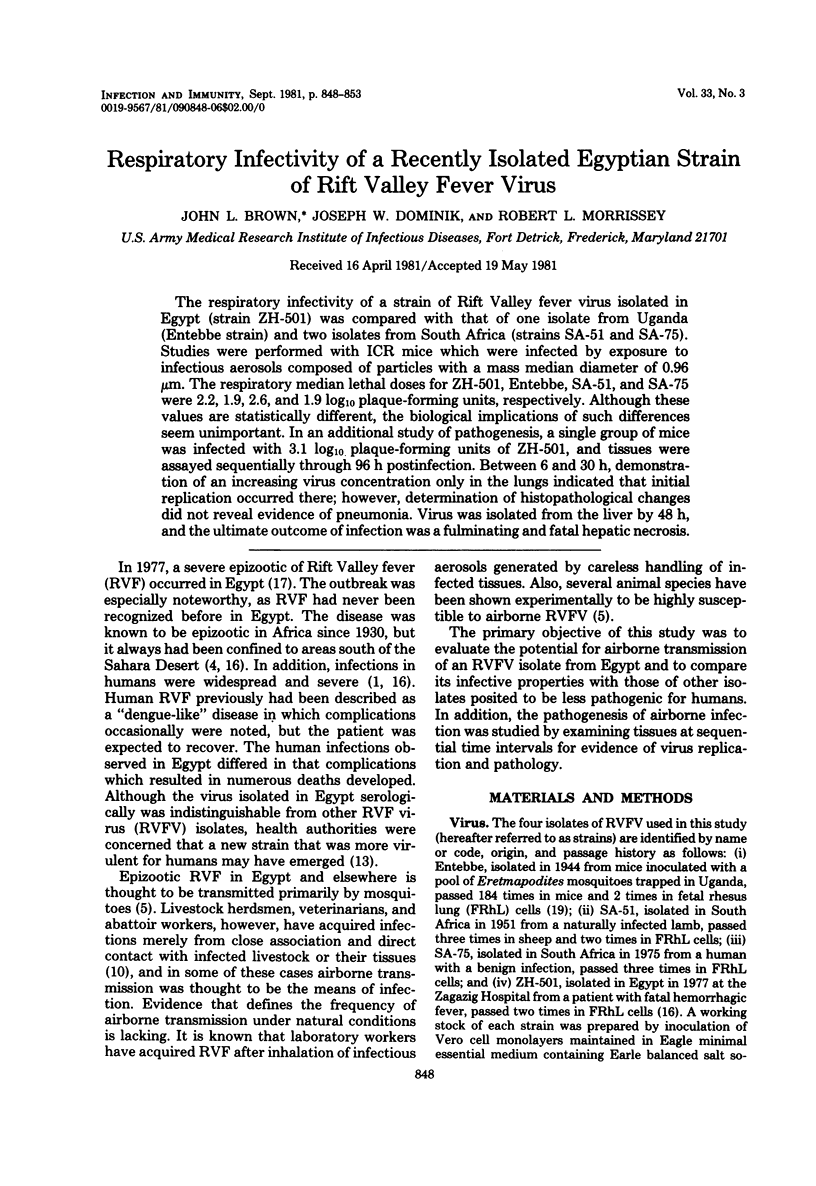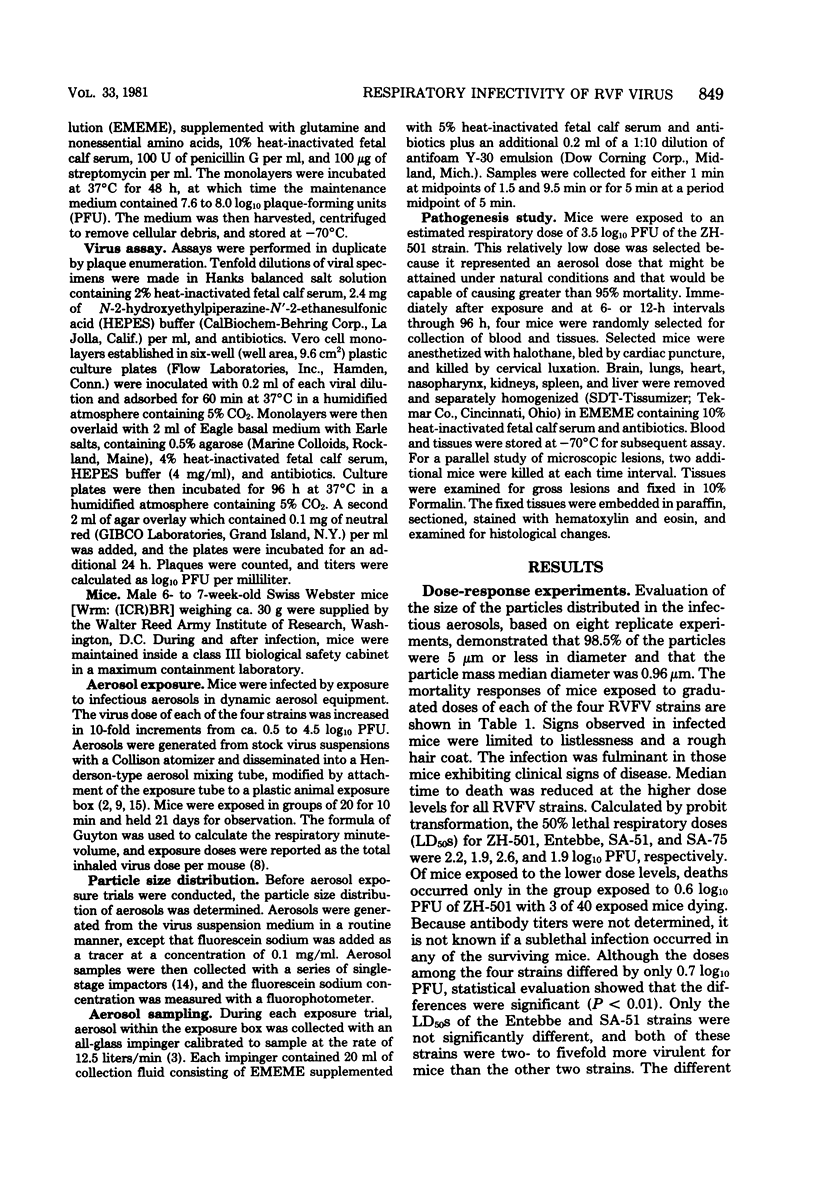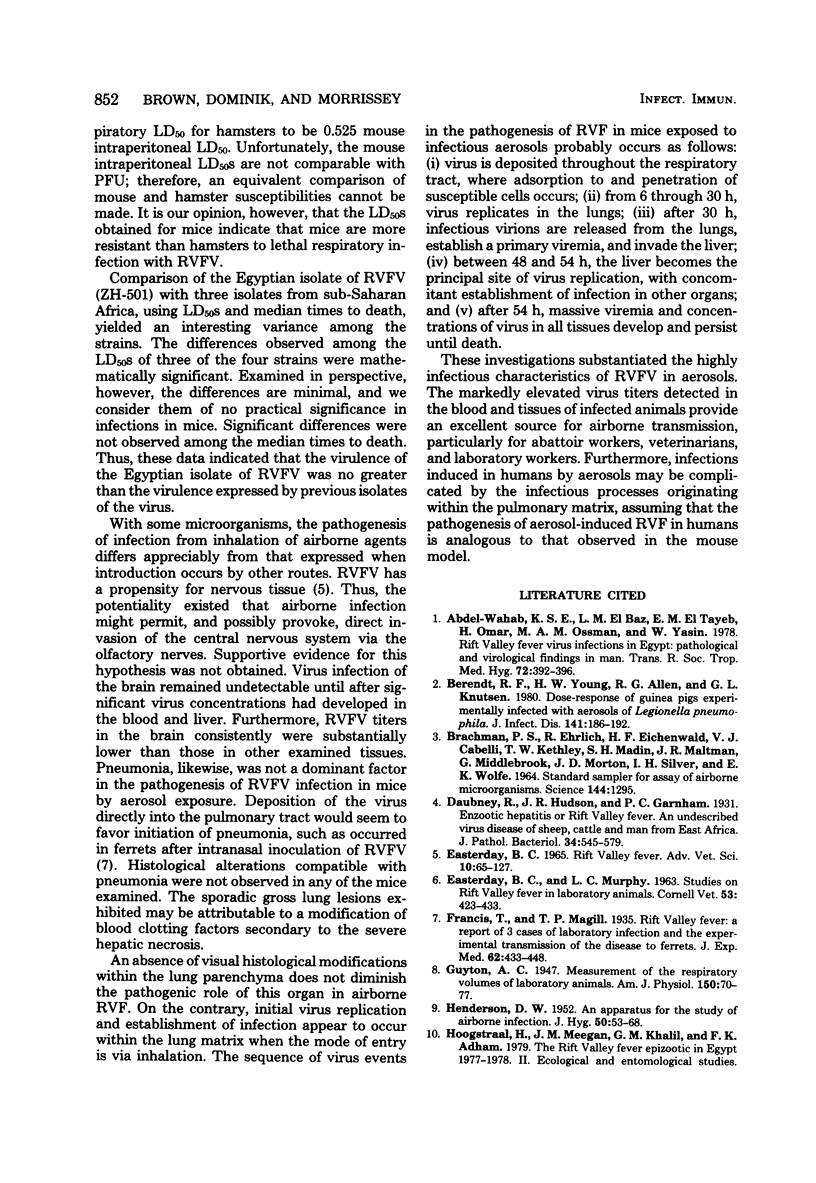Abstract
The respiratory infectivity of a strain of Rift Valley fever virus isolated in Egypt (strain ZH-501) was compared with that of one isolate from Uganda (Entebbe strain) and two isolates from South Africa (strains SA-51 and SA-75). Studies were performed with ICR mice which were infected by exposure to infectious aerosols composed of particles with a mass median diameter of 0.96 micrometer. The respiratory median lethal doses for ZH-501, Entebbe, SA-51, and SA-75 were 2.2, 1.9, 2.6, and 1.9 log10 plaque-forming units, respectively. Although these values are statistically different, the biological implications of such differences seem unimportant. In an additional study of pathogenesis, a single group of mice was infected with 3.1 log10 plaque-forming units of ZH-501, and tissues were assayed sequentially through 96 h postinfection. Between 6 and 30 h, demonstration of an increasing virus concentration only in the lungs indicated that initial replication occurred there; however, determination of histopathological changes did not reveal evidence of pneumonia. Virus was isolated from the liver by 48 h, and the ultimate outcome of infection was a fulminating and fatal hepatic necrosis.
Full text
PDF





Selected References
These references are in PubMed. This may not be the complete list of references from this article.
- Abdel-Wahab K. S., El Baz L. M., El-Tayeb E. M., Omar H., Ossman M. A., Yasin W. Rift Valley Fever virus infections in Egypt: Pathological and virological findings in man. Trans R Soc Trop Med Hyg. 1978;72(4):392–396. doi: 10.1016/0035-9203(78)90134-7. [DOI] [PubMed] [Google Scholar]
- Berendt R. F., Young H. W., Allen R. G., Knutsen G. L. Dose-response of guinea pigs experimentally infected with aerosols of Legionella pneumophila. J Infect Dis. 1980 Feb;141(2):186–192. doi: 10.1093/infdis/141.2.186. [DOI] [PubMed] [Google Scholar]
- EASTERDAY B. C., MURPHY L. C. STUDIES ON RIFT VALLEY FEVER IN LABORATORY ANIMALS. Cornell Vet. 1963 Jul;53:423–433. [PubMed] [Google Scholar]
- Easterday B. C. Rift valley fever. Adv Vet Sci. 1965;10:65–127. [PubMed] [Google Scholar]
- HENDERSON D. W. An apparatus for the study of airborne infection. J Hyg (Lond) 1952 Mar;50(1):53–68. doi: 10.1017/s0022172400019422. [DOI] [PMC free article] [PubMed] [Google Scholar]
- Keefer G. V., Zebarth G. L., Allen W. P. Susceptibility of dogs and cats to Rift Valley fever by inhalation or ingestion of virus. J Infect Dis. 1972 Mar;125(3):307–309. doi: 10.1093/infdis/125.3.307. [DOI] [PubMed] [Google Scholar]
- Larson E. W., Dominik J. W., Slone T. W. Aerosol stability and respiratory infectivity of japanese B encephalitis virus. Infect Immun. 1980 Nov;30(2):397–401. doi: 10.1128/iai.30.2.397-401.1980. [DOI] [PMC free article] [PubMed] [Google Scholar]
- Laughlin L. W., Meegan J. M., Strausbaugh L. J., Morens D. M., Watten R. H. Epidemic Rift Valley fever in Egypt: observations of the spectrum of human illness. Trans R Soc Trop Med Hyg. 1979;73(6):630–633. doi: 10.1016/0035-9203(79)90006-3. [DOI] [PubMed] [Google Scholar]
- MALLIGO J. E., IDOINE L. S. SINGLE-STAGE IMPACTION DEVICE FOR PARTICLE SIZING BIOLOGICAL AEROSOLS. Appl Microbiol. 1964 Jan;12:32–36. doi: 10.1128/am.12.1.32-36.1964. [DOI] [PMC free article] [PubMed] [Google Scholar]
- Meegan J. M., Hoogstraal H., Moussa M. I. An epizootic of Rift Valley fever in Egypt in 1977. Vet Rec. 1979 Aug 11;105(6):124–125. doi: 10.1136/vr.105.6.124. [DOI] [PubMed] [Google Scholar]
- Meegan J. M. The Rift Valley fever epizootic in Egypt 1977-78. 1. Description of the epizzotic and virological studies. Trans R Soc Trop Med Hyg. 1979;73(6):618–623. doi: 10.1016/0035-9203(79)90004-x. [DOI] [PubMed] [Google Scholar]


